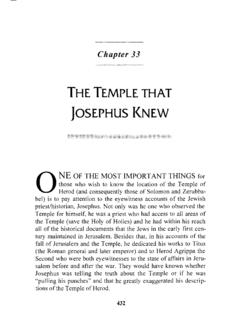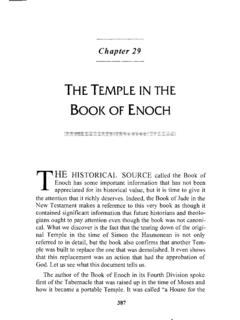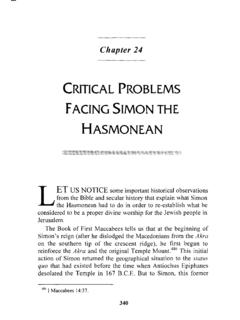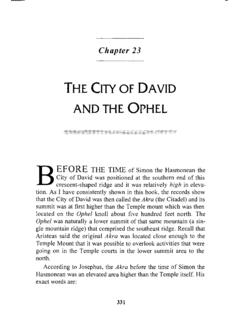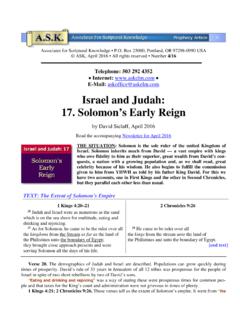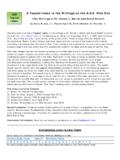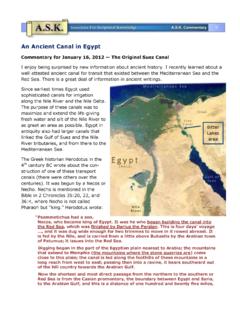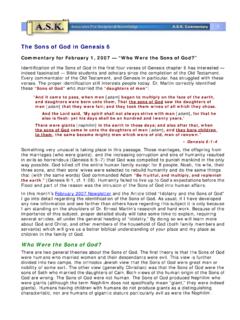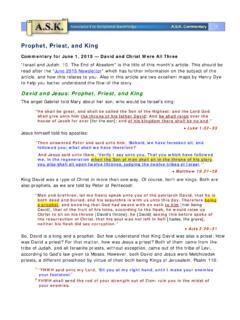Transcription of THE ORIGINAL TEMPLE OVER THE GIHON SPRING
1 Chapter 20 THE ORIGINAL TEMPLE OVER THE GIHON SPRING THERE ARE EARLY HISTORIANS who give abundant information of the actual location of the Temples in Jerusalem. It is time we look at the testimonies of these early eyewitnesses and their united witness that the Temples were positioned over the GIHON SPRING . Let us first look at the account of Aristeas, a Jew from Egypt who visited Jerusalem about fifty years after the time of Alexander the Great. Aristeas gave a de-tailed description of the TEMPLE and Jerusalem, and modern scho-lars and theologians should be aware of what he stated as an observer. His account is very instructive. We of modern times possess the actual written words of Aris-teas. Prof. Gifford of England translated an English version of this early writer, which gives a rendition preserved by Eusebius. Recall that Aristeas was speaking about the Jerusalem of his day (early third century before Jesus). In his description of Jerusalem and TEMPLE , he tells us that in the interior of the TEMPLE was an impor-tant geographical feature that serves as a topographical benchmark 288 The Temples that Jerusalem Forgot 289 to determine where the TEMPLE was located.
2 He said there was within the TEMPLE a natural SPRING gushing up that gave an abun-dance of water to the Sanctuary. He could not be clearer. "There is an inexhaustible reservoir of water, as would be expected from an abundant SPRING gushing up naturally from within (the TempleJ; there being moreover wonderful and indescribable cis-terns underground, of five furlongs [3000 feet away], according to their showing, all around the foundation of the TEMPLE , and countless pipes from them, so that the streams on every side met together [at the TEMPLE site]. And all these have been fastened with lead at the bottom and the side-walls, and over these has been spread a ~reat quantity of plaster, all having been carefully wrought."3 8 The Only SPRING in Jerusalem Was the GIHON Within the biblical period, historical records show the ORIGINAL TEMPLE was located over the GIHON SPRING , and modern geological surveys reveal that the only SPRING within five miles of Jerusalem was the GIHON .)
3 It was because of this strategic location of this SPRING that the earliest settlement at Jerusalem was in that area. The first name for Jerusalem was Migdal Edar (Tower or Cita-del of the Flock). It was associated in history with Jacob and is mentioned in Genesis 35:21 and in Micah 4:8. This site later became equivalent to the ORIGINAL Mount Zion. The reason such a Citadel existed in the time of Jacob was because of the high eleva-tion of the area, plus the existence of the perennial SPRING at its base. These factors provided the security that people needed to build and to defend an important city, which the Canaanites finally called Jebus. Without doubt, the GIHON SPRING was the essential feature (besides the fact that the area was elevated for protection from invaders) which prompted early people to pick this area for settle-ment. But note. There was no SPRING of any kind in the region where the later Dome of the Rock was situated.
4 This is one major reason why no early settlements were made in that area north of the ORIGINAL Zion. 378 Eusebius' recording of Aristeas, Preparation of the Gospel, 290 The Temples that Jerusalem Forgot The only SPRING in Jerusalem was the GIHON , yet ancient histori-ans said the area around the SPRING was desert-like. We have abun-dant historical evidence to show this was true. At the end of the first century , Strabo the Greek geographer described the city of Jerusalem as "rocky, and although well supplied with water, it is surrounded by a barren and waterless territory. "379 Dion Cas-sius in the second century said the same There was even more geographical precision given about Jerusalem in the period just before that of Simon the Hasmonean. Eusebius in his Prepa-ration of the Gospel quoted from Alexander Polyhistor (who wrote in the early first century ) who cited earlier writers con-cerning Jerusalem. Note what Eusebius quoted from Polyhistor.
5 "Timochares, in his Life of Antiochus, says that Jerusalem has a cir-cuit of forty furlongs [including lands surrounding the city for 2000 cubits], and is difficult to take being shut in on all sides by abrupt ravines: and the whole city is flooded with streams of water, so that even the gardens are irrigated by waters which flow from the city. But the country from the city as far as forty furlongs [five miles] is without water: but beyond the forty furlongs [five miles] it is well watered."381 This description by Timochares concerned Jerusalem before Simon the Hasmonean. Only within the City of Jerusalem itself was there abundant water. This had to come from the GIHON SPRING . The next reference by Polyhistor quoted by Eusebius, shows that the only water at Jerusalem (again, before the time of Simon the Hasmo-nean) came from a single SPRING in the city. "The author of the Metrical Survey of Syria says in his first book that Jerusalem lies upon a lofty and rugged site: and that some parts of the wall are built of polished stone, but the greater part of small stones [rubble]; and that the city has a circuit of twenty-seven furlongs [using the 1000 cubit scale], and that there is also within the place a SPRING which spouts up abundance of water.
6 "382 This single " SPRING " (Jerusalem's only water source) referred to 379 Strabo, Book XVI, 2:36. 380 Dion Cassius, 66:4. 381 Eusebius, quoting Polyhister in Preparation of the Gospel, , 382 Eusebius, Preparation of the Gospel, , The Temples that Jerusalem Forgot 291 by the author of the Metrical Survey was, again, the GIHON . Indeed, there is more information given by Polyhistor about early Jerusa-lem before the time of Simon the Hasmonean. He quoted a person named Philo (a man of the second century or even earlier). Polyhistor stated: "Philo too says, in his Account of Jerusalem, that there is a fountain [a single SPRING ], and that it is dried up in winter, but becomes full in summer."383 Philo went on to say that this fountain produced a "joyous stream, flooded by rain and snow, [which] rolls swiftly on beneath the neighboring towers, and spreading over the dry and dusty ground .. the blessings of that wonder-working fount [the single SPRING in Jerusalem].
7 "384 Eusebius continued by stating that this Philo called that single SPRING "the High Priest's fountain and the canal that carries off the water, he [Philo] proceeds as follows: A headlong stream [from the fountain] by channels underground. the pipes pour forth.' "385 This description by the early writer named Philo describes per-fectly the Jerusalem before the time of Simon the Hasmonean. Not only was there a single SPRING (called the SPRING of the High Priest, which connected the :ipring with the TEMPLE ). but it produced waters that ran "beneath [or, underneath] the towers" of the city walls. The waters from that SPRING were carried off in under-ground channels" (an apt description of Hezekiah's tunnel and the Siloam conduit that carried water from the GIHON SPRING to the southern area of the city). These geographical observations given by this writer named Philo show there was only one water source in Jerusalem, the GIHON SPRING .
8 There was, however, a place called the En-Rogel located about a third of a mile southeast of the City of David. This was NOT a SPRING . George Adam Smith in his celebrated survey of the city of Jerusalem, referred to the professional appraisal of Sir Charles Wilson. Sir Charles examined the En-Rogel site very 383 Eusebius, ibid., 7. 384 Eusebius, ibid. 385 Eusebius, ibid., emphasis mine. 292 The Temples that Jerusalem Forgot closely. He determined it was actually a 135 foot well. It is NOT (nor had it ever been) a SPRING like the Prof. A vigad con-firms this: "The GIHON SPRING is Jerusalem's only supply of fresh water in early antiquity. South of this hill is another minor water source, the Rogel SPRING , which is actually only a wel/."387 The single SPRING in the Jerusalem area was the GIHON , and Philo associated that SPRING with the High Priest who, of course, gov-erned all TEMPLE activities. This dovetails with the description given by Aristeas about 50 years after Alexander the Great, and Tacitus 300 years later.
9 Both Aristeas and Tacitus dogmatically state this natural SPRING was found within the precincts of the TEMPLE at Jerusalem. These geo-graphical facts from eyewitness accounts totally disqualify the area around the Dome of the Rock as having any relevance in locating the site of the Temples of Solomon, Zerubbabel and Herod. Without any doubt, the historical sources are consistent in placing the ORIGINAL Temples over the GIHON SPRING located in the center part of the "crescent-shaped" city of Jerusalem. All these reports place Jerusalem solely on the southeast ridge which, in the time of Josephus, had become known as the "Lower City." God's SPRING Waters The Holy Scriptures consistently proclaim that the TEMPLE at Jerusalem represented a physical replica on earth of God's official residence in heaven. The various rooms, furniture and household items in God's heavenly palace were exactly reflected in God's residence on earth in the Tabernacle and the later Temples in an anthropomorphic way.
10 Regarding these amenities, we read in the Scriptures that God has in His heavenly residence what we would call " SPRING waters." These waters are supposed to supply God and His household with the essential "waters'' that we on earth asso-ciate with the creation and perpetuation of life, and what is re-quired to maintain ordinary cleanliness as well as ritualistic purity. 386 George Adam Smith, Jerusalem, , 387 Avigad, Discovering Jerusalem, The Temples that Jerusalem Forgot 293 The authors of the Scriptures give many descriptive accounts that relate these symbolic agreements between God's earthly "House" (the Tabernacles and Temples) and His heavenly Sanctuary. This is one main reason why it was deemed essential by the biblical writers that there be a SPRING within the interior of the Temples. A New Testament reference indicates this essential fea-ture in association with God's divine domicile. "And I John saw the holy city new Jerusalem, coming down from God out of heaven, prepared as a bride adorned for her husband.
